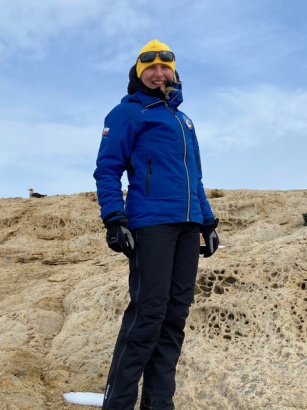First MAESTRO grant at the Institute
We are very proud to announce that Prof. Monika A. Kusiak from the Department of Polar and Marine Research IGF PAN has received a prestigeous MAESTRO grant for the implementation of the project entitled "At the crossroads: Paleogeographic position of the Bunger Hills, East Antarctica".
MAESTRO is one of the most prestigious calls for research projects for experienced scientists aimed at implementing pioneering scientific research, including interdisciplinary research, important for the development of science, going beyond the current state of knowledge and which may result in scientific discoveries.
So far, the National Science Centre has awarded only three MAESTRO grants in Earth sciences, the last one over 10 years ago. Prof. Kusiak's project is the first grant of this type in our Institute and the fourth in our discipline. It is also the first polar grant of this type. MAESTRO grants guarantee funds for salaries for the research team, including scholarships for students or PhD students, purchase or production of research equipment and covering other costs related to the expenses necessary to carry out the research project.
The CROSSROADS project includes geochemical and geophysical studies of geological relationships on three continents: Eastern Antarctica, Western Australia and the Indian Peninsula. The separation of India and Australia from Antarctica meant the final breakup of Gondwana (approx. 500 million years ago). Therefore, the continental edges of these three blocks can provide a wealth of evidence for the breakup of the supercontinent. It is planned to collect new geochemical and paleogeographic data and compare them with existing seismic, aeromagnetic and gravity data sets to reconstruct the initial configuration of these blocks. In addition to being able to reconstruct the final break-up of the supercontinent Gondwana, this project will provide important information on their possible relationship to the supercontinent Rodinia (ca. 1 billion years ago).
The project will test three competing scientific hypotheses: whether the Bunger Hills were associated with 1) the Yilgarn Craton and Albany Fraser Orogen (Australo-Antarctic continent); 2) the Mawson Craton (Australo-Antarctic continent) or 3) the Indo-Antarctic continent, which may also be related to the Pinjarra Orogen in Western Australia
Prof. Monika A. Kusiak has just completed a big Norwegian-funded project entitled "Poles together – missing link between Arctic and Antarctic early Earth record", in which she focused on the study of the oldest rocks on Earth. When asked why, after many years of research on the beginnings of the Earth, she is interested in much younger rocks came from, she replies: The beginnings of the Earth still interest me and this is of course a topic that is in the center of attention. The inspiration began not necessarily from the "middle ages" of the Earth, but from the research area - the Oasis, or the Bunger Hills in East Antarctica. The primary goal of the expedition to the Dobrowolski Station in 2021/22 was to recognize the scientific potential. It was then that I began to be interested in what interesting geology could be found in the area where the Station stands. The Bunger Hills are an amazing place on Earth, worthy of scientific interest and, as you can see, funding.
Before the opening of the Indian and South Oceans, a part of East Antarctica, Western Australia and the Indian Peninsula were part of the supercontinent Gondwana. The Bunger Hills are located at the intersection of these three large lithospheric plates. The so-called "triple junction" was located here. This is a key area for understanding the paleogeographic evolution of supercontinents, not only Gondwana, but also Rodinia.
As Professor Monika A. Kusiak says, this project is important and ambitious, due to the fact that East Antarctica, Australia and the Deccan Peninsula constitute a unique geotectonic system and research testing ground. The paleogeographic reconstructions we will start with are only a stage, a tool for studying the processes that underlie plate tectonics, the processes of amalgamation and breakup of supercontinents, the processes of interaction between the crust and the mantle - she explains. A large part of the research work will focus on the analysis of large-scale magmatism events and the study of Large Igneous Provinces (LIPs).
The MAESTRO grant provides the opportunity to create a large research team. According to Prof. Kusiak, the project team was a very strong point of the application. The project will be carried out by excellent specialists representing a wide range of fields of Earth Sciences. From the Institute of Geophysics of the Polish Academy of Sciences, this will include Dr. Krzysztof Michalski, who will be responsible for paleomagnetic work. The Institute will employ six additional people to carry out the project, including two post-docs, two doctoral students and two technical staff. Additionally, the following people have expressed their willingness to participate in the project (in alphabetical order): Lars Augland, Santanu Bhowmik, Daniel Dunkley, Raphael Quentin de Gromard, Jacqueline Halpin, Uwe Kircher, Zheng-Xiang Li, Yebo Liu, Geoffrey Manby, Martin Whitehouse, Simon Wilde and Keewook Yi. These are scientists from 6 countries: Australia (Curtin University in Perth, University of Tasmania in Hobart, Geological Survey), India (Indian Institute of Technology in Kharagpur), Korea (Korean Basic Science Institute), Norway (Oslo University), Sweden (Museum of Natural History in Stockholm) and Great Britain (Museum of Natural History in London).
We encourage you to read the project summary.
Congratulations!






















